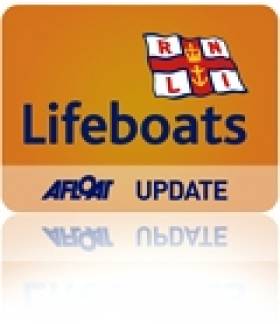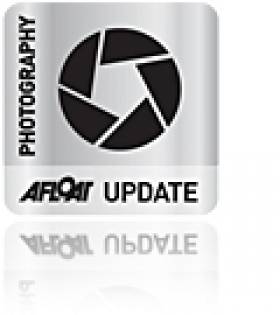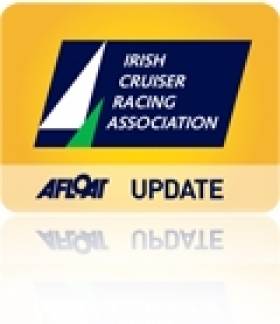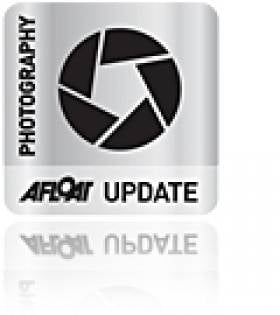Displaying items by tag: Dun Laoghaire
Dun Laoghaire RNLI's New Inshore Lifeboat Gets First Rescue
The incident occurred shortly after 11.00pm when the pair realised their route off the rocky outcrop at Maretimo was cut-off by the incoming tide since their arrival on foot earlier in the day. The location is a scenic though lesser-known beauty-spot that features a disused Victorian-era harbour as well as other derelict structures.
The new IB1-type Inshore Lifeboat (ILB) was replaced the existing D-Class boat at Dun Laoghaire last Thursday and last night's service was the first
for the new boat that features a larger engine, faster speed and improved navigation capabilities.
Supernova Sails to Dublin Bay Sailing Club Success
Fresh from his third overall result at the Irish Cruiser Nationals a week ago, Ken Lawless was back at the top of the Class three fleet tonight when his yacht Supernova sailed to success in a warm Summer breeze on Dublin Bay.
It may have just appeared tightly bunched to shoreline spectators but nearly every boat in the Dublin Bay Sailing Club (DBSC) fleet appeared to round Pier mark tonight within a time frame of just a few minutes. It was a spectacle worth watching as the massive fleet – of up to 200 boats – reached the mark in Scotsman's bay and hoisted colourful spinnakers before heading off for a lap of Dublin Bay, in a perfect 10-12 knot southerly sailing breeze.
DUBLIN PORT Dublin Bay Sailing Club Results for 3 JUNE 2010
BENETEAU 31.7 - ECHO 1. Magic (D.O'Sullivan/D.Espey), 2. Levana (Jean Mitton), 3. Bluefin Two (M & B Bryson)
BENETEAU 31.7 - 1. Magic (D.O'Sullivan/D.Espey), 2. Levana (Jean Mitton), 3. Bluefin Two (M & B Bryson)
CRUISERS 0 - ECHO 1. Lively Lady (Derek Martin), 2. WOW (George Sisk), 3. Tsunami (Vincent Farrell)
CRUISERS 0 - 1. WOW (George Sisk), 2. Lively Lady (Derek Martin), 3. Tsunami (Vincent Farrell)
CRUISERS 1 - ECHO 1. Errislannan (Patrick Kirwan), 2. Joker 11 (John Maybury), 3. Axiom (M.O'Neill)
CRUISERS 1 - 1. Joker 11 (John Maybury), 2. Errislannan (Patrick Kirwan), 3. Contango (Barry Cunningham)
CRUISERS 2 - ECHO 1. Witzend 11 (Peter Conlon), 2. Red Rhum (J Nicholson), 3. Jawesome 11 (V.Kennedy/M.Dyke)
CRUISERS 2 - 1. Witzend 11 (Peter Conlon), 2. Red Rhum (J Nicholson), 3. Jawesome 11 (V.Kennedy/M.Dyke)
CRUISERS 3 - ECHO 1. Hyflyer (John Barnard), 2. Asterix (J.Counihan/F.Meredith), 3. Two Step (Ross Doyle)
CRUISERS 3 - 1. Supernova (K.Lawless et al), 2. Two Step (Ross Doyle), 3. Asterix (J.Counihan/F.Meredith)
DRAGON - 1. Diva (R.Johnson/R.Goodbody), 2. Phantom (D.Williams/P.Bowring), 3. Chiang (Iain Finnegan)
FLYING FIFTEEN - 1. Flyer (Niall Coleman), 2. The Gruffalo (Keith Poole), 3. Deranged (C.Doorly)
GLEN - 1. Glenariff (Adrian Lee), 2. Pterodactyl (R & D McCaffrey), 3. Glendun (B.Denham et al)
RUFFIAN 23 - 1. Ruffles (Michael Cutliffe), 2. Diane ll (Bruce Carswell), 3. Shannagh (S.Gill/P.MacDiarmada)
SB3s - 1. Sin Bin (Barry O'Neill), 2. Flutter (Andrew Algeo), 3. Sunday Brunch (D.Dwyer/R.Tate)
SHIPMAN - 1. Whiterock (Henry Robinson), 2. Curraglas (John Masterson), 3. Just Good Friends (Michael Carroll)
SIGMA 33 - 1. White Mischief (Timothy Goodbody), 2. Rupert (R.Lovegrove/P.Varian), 3. Miss Behavin' (A Bell et al)
SQUIB - 1. Why Not (Derek & Jean Jago), 2. Perfection (Jill Fleming), 3. Little Demon (Marie Dee)
WHITE SAIL CRUISERS - ECHO 1. Nauti-Gal (J & J Crawford), 2. Act Two (Michael O'Leary et al), 3. Finnegans Wake (T.Rowlands et al)
WHITE SAIL CRUISERS - 1. Act Two (Michael O'Leary et al), 2. Nauti-Gal (J & J Crawford), 3. Just Jasmin (Philip Smith)
Lord Nelson Pays Dun Laoghaire a Visit
The Lord Nelson struck a lovely sailing pose crossing Dublin Bay this week. The disabled sail training vessel berthed overnight in Dun Laoghaire Harbour and Gareth Craig photographed her leaving. Images on the gallery now.
Looking for further reading on Tall Ships in Ireland? Click the links below:
Click this link to read all our Tall Ships Stories on one handy page
Previewing Ireland's Tall Ships 2011 Season
Can Ireland Get a New Tall Ship?
Confirmation has been received from Dun Laoghaire Harbour that the Irish Match Racing has the green light to hold the Weir & Sons Leinster Match Racing Open in side Dun Laoghaire harbour. So with plenty of wind shifts to contend with and a constrained starting area it’s likely that racing will be extremely tight with plenty of boat on boat action.
Arrangements are still being made for a live PA commentary. After the grand job he did with the Howth Club Champion of Champions event we are hoping Noal Davidson will come down to MC and do a live Internet feed of the event. The hope is to beam this back to the Royal Irish with racing shown on big screens in the bar all day. Together with a pig roast on the Saturday evening there should be some buzz around the club.
Weir & Sons of Grafton Street have kindly agreed to provide prizes. We’re not sure that they will quite stretch to the Rolex we asked for but having this kind of support for the event does mean that we can properly recognise the contribution of all the sailors to the success of their teams. North Sails Ireland will still be absent from the Leinsters and a clash with the SB3 Northern means that MadMatch Racing will away. How ever John Sheehy and the Royal St George machine will be back in action and no doubt eager to reassert their authority after Team Lazarus moved to the top of the Tour rankings following the Investwise Dublin Match Racing Open.
UK National Youth Champions Team Echo Racing will also be back for another crack as will Casey Racing, Cross Community Alliance, Mahon Racing and Team O’Loughlin. Alex Barry returns to the 2010 Tour for the first time since a strong 3rd place showing at last years Leinsters and it will be interesting to see how he goes but the real interest is in how the two teams coming from this years all conquering George Gladiators team racing team will fair.
Marty O’Leary and Sam Hunt have had a tremendous start to 2010, taking the National team racing title and placing strongly at the UK championships and the Wilson Trophy. The Leinsters will not only see them pitted against each other but also against the skipper who’s team they where part of on the 2009 Tour, none other than John Sheehy.
ICRAs wrap up with blue skies
Whoever sold their soul for the weather, it was worth it. Three days of consistent sunshine and sailing breeze is nearly unheard of on Dublin Bay, but by whatever means, the Liebherr ICRA Cruiser Nationals went off without a hitch.
Day three concluded with winds of 10 knots and flat seas providing exciting and tight racing. After the first race was sailed today the fleets swapped courses and sailed on their alternative course for the second race adding variety and spice to the racing.
Dominating proceedings from before the start gun with a win in the feeder race from Cork, Anthony O’Leary in Antix on 9.5 pts took the Class 0 IRC title by the slimmest of margins. Despite stringing together five winds in a row at the start, just a single point separated them from Dave Dwyer’s Marinerscove.ie in the end, when Mariners finished with 10.5 pts. Marinerscove, sailed by Nicholas O’Leary, had two bullets on the final day, the lighter airs suiting the Mills 39 over the Ker, and with Antix yielding 40 seconds in the hour. In the strong tides and light winds Antix secured second and third today. Peter Rutter’s Quokka 8, a British Commodore’s Cup Team member, had a third and second today but was very consistent throughout the event and was able to discard a 6th and this cemented his third place on 16 points.
On the whole there were no major surprises in the IRC results with just a couple of changes in placings, with a notable exception in Division One IRC, with the emergence of Tony Fox’s A35 Gringo to take second place. Gringo, who was lying in sixth place yesterday, today scored two seconds and with a discard of 19 this was enough to bring him to second place. The winner, Rockabill, sailed by Mel Collins, had five firsts and a second in the series in what was possibly, with 29 boats, the most competitive of the classes. The best of the J109s, Joker 2, was third.
In Class Two an interesting fact is that Corby 25s took places one, two and three. The pre-race favourites the Colwell/Murphy Kinetic, took the trophy from two Cork boats, Denis Coleman in Thunderbird second and Vinny O’Shea in Yanks and ffrancs third.
In Class Three Flor O’Driscoll in Hard on Port lost his crown to the Faroux Quarter tonner Tiger of Joxer O’Brien and the Kenefick father-and-son pairing followed in third place by the quarter tonner Supernova from the Royal Irish Yacht Club.
The non-spinnaker Division 5 sailed only five races for the series and Vincent Farrell in Tsunami took the crown here followed by Philip Dilworth in Orna and Liam Coyne in Lula Belle.
Non spinnaker Division 6 was won by Joe Carlton in Voyager, followed by Peter Dunlop from Wales in Mojito with Howth Yacht Club Brazen Hussy of J.Barry and M. Stirling in third place.
All in all it was an excellent series with strong competition in all fleets and will be a hard act to follow for the hosts of 2011, the Royal Cork Yacht Club.
Perfect Conditions on Day Two of ICRA Nationals
Blue skies coloured Dublin Bay again yesterday with a sea breeze of 12 knots providing perfect sailing conditions for the ICRA Nationals, writes Claire Bateman. The results illustrate the closeness of the competition in most divisions. Anthony O’Leary in Antix is leading IRC 0 after five races and indeed had the unusual situation today of having a tied result with Dave Dwyer’s Marinerscove.ie on corrected time each receiving 1.5 points in Race four. This is keeping it very much in the O’Leary family as it is Anthony’s son Nicholas is helming Mariners cove. Antix is very much the dominant force in Class zero, discarding a fifth after yesterday's racing to leave her with four wins on the scorecard.
ICRA members will be interested to know that Mariners had a better day scoring a total of 4.5 from the three races and as the defending champion is now a mere three points adrift of the leader. It is great to see Peter Rutter’s Quokka 8 competing and he is now lying third on 17 points.
In Class One IRC the O’Higgins Rockabill V appears to be walking away with the series having scored three wins and two seconds leaving him with seven points. Currently following on Rockabill’s heels, is a plethora of J109s led by J.Maybury’s Joker 2 followed by Jalapeno and Jelly Baby. However, should there be a discard tomorrow Jelly Baby could come up the leader board and it is all to play for here.
In Class Two IRC the pre race favourite, Kinetic, the Colwell/Murphy well sailed Corby 25 and defending title holder, has built up a good lead and is currently on 12 points followed by Denis Coleman’s Corby 25 Thunderbird from Cork with Anthony Gore Grimes in the X302 DUX just one point adrift. Things are very tight with the top two boats in Class Three IRC with just one point separating the current leader the O’Brien, Kenefick and Kenefick, Tiger, from the defending title hoilder Flor O’Driscoll in his J24 Hard on Port.
Currently lying third is Supernova and it most def initely is all to play for in this class.
In the Non Spinnaker Division Five IRC four races have been sailed and they have already received a discard. Counting the discard and leading on 4 points is Tsumnai, one point ahead of Orna followed by Lula Belle on 7 points.
In the Non Spinnaker Division 6, again with one discard applied, the Howth Yacht Club Dehler 34 Voyager is on four points, two points ahead of fellow HYC yacht Brazen Hussy, and a Welsh raider from Pwllheli SC, Mojito, who is on equal points with Brazen Hussy.
In Class 0 ECHO Marinerscove.ie continues to hold her lead followed by Tiamat and Antix respectively. In Class One ECH0 Rockabill V leads Joker 2 with Donal O’Leary’s D- ‐Tox in third position. In Class Two ECHO Kinetic leads Thunderbird Page 2 followed by Indigo who is on equal points with Thunderbird. Class Three ECHO has very tight results to date at the top with only one point separating the leading three boats.
The current leader is Jibberish on 33 points, followed by Tiger and Supernova both on 34 points. However, it is Tiger has the more consistent results which could stand to her in the case of a discard. Class Five ECHO Adelie is on 7 points, Lula Belle also has 7 points and the Sigma 38 Persistance is just one point adrift on 8 points. Class 6 ECHO is currently led by Voyager on 5 points followed by Brazen Hussy on 7 points and Mojito on 8 points.
A lot at stake for today in many classes.
Colin and Casey Wins Fireball DBSC Race
Neil Colin's appropriately named Elevation went straight to the top of the local Dublin Bay Sailing Club Fireball dinghy fleet in last night's race in Scotsman's Bay. Racing in moderate westerly conditions and an ebb tide, Marie Barry's Reality Check was second and Incubus (S Oram) third. In the IDRA 14 dinghy class Frank Hamilton's Dunmoanin continues his winning run. Full sailing results click read more.
DUBLIN PORT Dublin Bay Sailing Club Results for 18 MAY 2010
CRUISERS 1 - 1. Jalapeno (Dermod Baker et al), 2. Lula Belle (Liam Coyne)
CRUISERS 3 - 1. Grasshopper 2 (K & J Glynn), 2. Chouskikou (R.Sheehan/R.Hickey), 3. Papytoo (M.Walsh/F.Guilfoyle)
CRUISERS 4 - 1. Maranda (Myles Kelly), 2. Aslana (J.Martin/B.Mulkeen), 3. Ghrazel (Charles Pearson)
FIREBALL - 1. Elevation (N.Colin/M.Casey), 2. Reality Check (Marie Barry), 3. Incubus (S Oram)
GLEN - 1. Glencorel (B.Waldock/K.Malcolm)
IDRA 14 FOOT - 1. Dunmoanin (Frank Hamilton), 2. Dart (Pierre Long), 3. Doody (J.Fitzgerald/J.Byrne)
MERMAID - 1. Tiller Girl (J.O'Rourke), 2. Lively Lady (G O'Neill & M Hanney), 3. Kim (D Cassidy)
PY CLASS - 1. Joan Flanagan (Laser), 2. Richard Tate (Laser), 3. David Dwyer (Laser)
RUFFIAN 23 - 1. Alias (D.Meeke/M.McCarthy), 2. Cresendo (L Balfe), 3. Diane ll (Bruce Carswell)
SIGMA 33 - 1. White Mischief (Timothy Goodbody), 2. Pippa lV (G.Kinsman/K.Blake/M.O'Brien)
SQUIB - 1. Little Demon (Marie Dee), 2. Periguin (N.Coakley/J.Redahan)
Royal St George Win Cumberland Cup
With a close to perfect score, Andrew Fowler's team of Sam Hurst, Brendan Fafliani, John Sheehy, Nick Smyth, Guy O'Leary, Peter Bailey and Phil Lawton from Royal St George YC in Dublin, won the 2010 Royal Thames Cumberland Cup from Ian Ilsley's team from Yacht Club de Monaco writes Malcolm McKeag. Firm friend and arch-rival of the home side the Southern Yacht Club of New Orleans was third, claiming by dint of that result the Bourgne Cup, contested on each and every occasion the clubs meet, in whatever larger competition..
Over three days at Queen Mary Water hard by Heathrow airport the seven teams sailed a total of 54 races in the international yacht club contest, ferried to and fro from the RTYC's Knightsbridge clubhouse in that iconic symbol of London, a bright scarlet Routemaster double-decker omnibus.
Sailing in a fleet of eight carefully-matched modified J80s the competition began with a two-day double round-robin in which each team raced each other team twice. St George topped the league, winning 11 out of their 12 matches and losing only to the hosts and current holders, Royal Thames, and thus apparently setting the scene for the finals. It was a scene dramatically re-shaped by the winner-take-all nature of the Cumberland Cup's competition structure.
With teams travelling from across the globe to compete in this regatta, the organisers deliberately eschew a competition format that eliminates teams early from the competition, espousing instead a format that keeps every team sailing into the final round. The result is The Ladder, which as some teams including the hosts found to their cost might be better termed The Greasy Pole. On The Ladder, a win carries the double bonus of promotion to the next rung – but every loss earns the double-penalty of relegation. On The Ladder, it is just possible by dint of really good sailing to redeem a disappointing result in the round-robin and climb all the way to the top – as did the Monegasques – while the series leaders – in this case the Irish – must not put a foot wrong if they are to retain their fingertip grip on the crown.
Thus on Sunday The Ladder's first and lowest rung saw the Germans face-off against the Kiwis for a chance for stardom, while Royal St George had to wait patiently to see which of the Yanks (and it's not often the team from New Orleans are called Yankees!) and the Brits would be first to step up to try and knock them off their perch. As matters transpired, it was Royal Thames who beat the Southerners to race against the champs: to no avail. Royal St George won.
After Round One, the Brits began what turned out to be their slide down The Ladder, while the visitors from the Mediterranean climbed ever higher. The Southern, meanwhile, had to dispose of Royal Port Nicholson if they were to have a chance, in Round Three and the final round of The Ladder, of another crack at the leaders.
With Port Nich out of the way, the crunch race in Round Three was that between the Southern – highly vocal as always – and Monaco, who had quietly beaten Royal Thames when Ben Clothier of the host club earned a penalty for inadvertently but illegally 'sculling' the boat with the rudder while trying to slow down to block his rival. Given that in the round-robin YCdeM had lost almost as many races as they had won (and then been penalised a further point for a violent T-bone collision in their early race against St George) it is not unkind to suggest that their presence, by Round Three, on the top rung of The Ladder had been predicted by few. But Ian Ilsley, their team captain who by his own admission 'hadn't team raced for years' had by now earned both the respect of his rivals and the nickname 'the Old Fox'.
Southern, in blue jackets, began by blowing the yellows away at the start to be a comfortable and apparently safe 1-2 at the windward end of the course – but somehow one of the YCM team managed to get close enough on the long run to engage a blue boat and suddenly it was Game On again. On the final beat all four boats were mixed together and the denouement came – as so often in this two-boat team racing where the crucial factor is that the team with the boat in last place loses the match – at, beyond, above and back round again to the finishing line, with a Southern boat blocking out one Monaco boat only to find his own way back blocked by the other Monaco boat. And vice versa. Finally a Southern boat crossed the finish line – only to cop a penalty by blocking the path of the last returning Monaco boat under the rule that says a boat no longer racing must not interfere with one that is still racing.
And so it was a Monaco-Ireland final. If anyone thought this would be a walk-over for the Irish, they were wrong. Monaco had their tails up and no mistake. Once again it was their down-wind sailing that kept them engaged and it was not until the final mark, when the Monaco boat in second earned a penalty, that it really was Game Over.
Monaco were justly pleased with their Ladder climb from 4th place after the Round Robin – but none could nay-say the Irish for their win. 15 matches sailed and only one of them lost.
Photos below and on our gallery by Ingrid Abery





More photos here on our gallery.
Antix Wins ICRA's Cork to Dublin Offshore
Cork Harbour saw the start of the feeder race to Dun Laoghaire for the Liebherr ICRA Nationals last Friday writes Claire Bateman. This race was mandatory for yachts wishing to compete in the Commodore's Cup to be held in the Solent in August and also served as a qualifier for any yacht wishing to compete in the Round Ireland Race from Wicklow in June.
This was the first opportunity the Irish team of Anthony O'Leary's Antix, David Dwyer's Marinerscove.ie and Andrew Creighton's Roxy 6 have had to sail together as Roxy, the yacht to fill the Class Three slot, only arrived in Cork Harbour fresh from the Dale-Nelson Yard in Wales two weeks ago.
Start photographs here.
Conditions on Friday night as the yachts came to the start line were magnificent. The harbour was resplendent bathed in brilliant sunlight with yachts from the Friday night Whitesail league flying everywhere in the 12-15knot NNW wind. The feeder race start saw the competitiors beat in the harbour to No.10 buoy where spinnakers were hoisted and they then ran back out the harbour creating a magnificent spectacle as they wove their way through the Whitesail Fleet.
Racing continued throughout the night and most of Saturday with the wind lightening and becoming fluky ranging from 8 to 16 knots providing excellent experience for the crews on the Commodore's Cup yachts. In fact Marinerscove lost out when sailing into a windless area under Wicklow Head and retired at that point but speaking with Dwyer after racing he said that it was nonetheless a wonderful training opportunity with the constant almost hourly sail changes required.
ICRA Offshore Trophy Race:
1. Antix Anthony O'Leary
2. Roxy 6 Rob Davies/Andrew Creighton
3. Gloves Off Kieran Twomey
4. D-Tox Donal O'Leary






































































